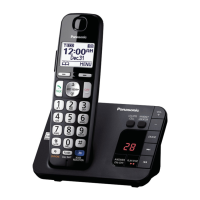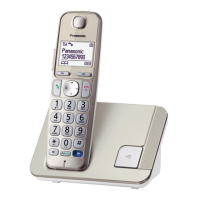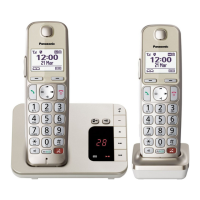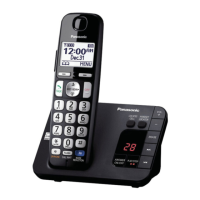Do you have a question about the Panasonic KX-TGE240 and is the answer not in the manual?
Details the models within the KX-TGE210, KX-TGE230, and KX-TGE240 series.
Lists supplied accessories for different unit quantities and their order numbers.
Lists optional accessories and their order numbers for purchase.
Information on adding optional handsets to expand the system.
Precautions to prevent injury and property loss during operation.
Guidelines for safe installation and placement of the unit.
Instructions and warnings regarding battery usage and charging.
General safety precautions for using the product.
Advice on base unit placement for optimal signal and sound quality.
Recommendations for operating environment to avoid interference and damage.
Instructions for cleaning the product to maintain its condition.
Technical details including standard, frequency, power, and operating conditions.
Guides users through connecting the base unit, charger, and installing batteries.
Instructions for charging the handset batteries and battery level indicators.
Important notes regarding connections and battery installation during setup.
Explains the eco mode feature for reducing power consumption.
Identifies and explains the buttons and indicators on the handset and base unit.
Details the controls and functions of the base unit.
Explains various icons shown on the handset and base unit displays.
How to change the display and voice guidance language settings.
Instructions for setting the current date and time.
Steps to record a personalized greeting message for the answering system.
Explains the functionality and usage of the Smart function key.
How to set the dialing mode (Tone/Pulse) based on telephone line service.
Instructions for making calls using the handset, speakerphone, and redial list.
How to make calls using the base unit.
How to redial the last number made.
How to change volume levels during a call.
How to use the pause function for specific call types.
Instructions on how to answer incoming calls on the handset and base unit.
Explains features like Hold, Mute, and volume adjustment during calls.
Information on using the Flash function for PBX or optional services.
How to use call waiting features with Caller ID.
How to use tone dialing with rotary/pulse service.
Feature to improve sound clarity in areas with interference.
Feature to reduce background noise for clearer conversations.
Feature to adjust voice quality for better hearing.
How to join an existing outside call with another unit.
Instructions for transferring calls and setting up conference calls.
How to find a misplaced handset by paging it.
Feature to locate a misplaced cell phone by calling it from the base unit.
Instructions for making intercom calls between units.
Detailed steps for initiating intercom calls from handset or base unit.
How to answer incoming intercom calls.
How the system works during a power failure using handset batteries.
Instructions for making calls when the unit is in power back-up mode.
How to answer calls when the unit is in power back-up mode.
Steps to add new contacts with names and phone numbers.
Guide for entering characters and names using the dial keys.
How to save numbers from the redial list into the phonebook.
How to save incoming call details into the phonebook.
How to organize phonebook entries into groups for easier management.
Customizing group names and assigning specific ringers.
How to locate and dial entries from the phonebook.
Instructions for modifying existing phonebook entries.
How to delete individual or all entries from the phonebook.
Feature to dial stored numbers sequentially during a call.
Instructions for assigning phone numbers to speed dial keys.
Methods for adding numbers to speed dial keys.
How to modify existing speed dial entries.
How to remove entries from speed dial.
How to view speed dial entries and initiate a call.
Overview of accessing features via display menus or direct command codes.
Reference table for menu operations and their corresponding codes.
Settings for alerts when new messages are received.
Various settings including ring count, recording time, and remote code.
How to turn the answering system's answer function on or off.
Accessing voice mail services provided by the phone company.
Details on paging and communicating between units.
Settings for date, time, memo alarms, and time adjustment.
Viewing speed dial entries.
Configuration options for ring adjustments, silent mode, date/time, and Caller ID.
Settings related to announcing caller information audibly.
Settings for managing key detectors, including naming and registration.
Features for blocking unwanted calls by number or range.
Settings for the cell locator feature.
Options for recording greeting messages.
Settings for voice mail access and tone detection.
Adjusting the brightness of the display.
Customizing the names of individual handsets.
Settings to enable or disable the display of handset names.
Settings for the smart function key.
Settings for automatically editing caller ID numbers.
Setting for automatically answering calls by lifting the handset.
Settings related to the telephone line, including dial mode and flash time.
Settings for sharing calls between units.
Process for registering new handsets to the base unit.
Settings related to power failure operation.
Options for changing display and voice prompt languages.
Setting up alarms with time, memo, and recurrence options.
Setting periods to prevent ringing for calls, with options to bypass silent mode.
Features for blocking unwanted callers and managing the call block list.
Instructions for storing single numbers or ranges for call blocking.
Setting to reject calls without caller ID information.
Option to disable the initial ring for blocked calls.
Managing entries within the call block list.
How to clear all entries from the call block list.
Customizing the names displayed for each handset.
Settings to enable or disable the display of handset names.
Process for registering new handsets to the base unit.
Steps to remove a handset's registration from the base unit.
Introduction to using Caller ID features and requirements.
Explains how caller information is displayed and handled.
How the unit handles and displays missed calls.
How the phonebook name is displayed when matched with caller ID.
Feature to audibly announce caller information.
How the phonebook name is announced for incoming calls.
Information about the caller list and how to view it.
Steps to review the caller list and dial back.
Using the Smart function key to access missed calls and messages.
How to modify phone numbers in the caller list for auto-editing.
Explanation of the auto-editing feature for caller ID numbers.
How to delete specific entries from the caller list.
How to clear the entire caller list.
Overview of the answering system's capabilities and settings.
Information on the recording capacity and message limits.
Instructions for enabling or disabling the answering system.
How greeting messages are played and options for using them.
Step-by-step guide to record a custom greeting.
Information on using the built-in pre-recorded greetings.
Instructions for listening to recorded messages via base unit or handset.
Controls for playback, skipping, and erasing messages.
Settings for alerts when new messages are received.
Setting for the base unit to beep when new messages are recorded.
Feature to notify the user via a phone call about new messages.
How to configure a number for new message alerts.
Enabling or disabling the notification feature for new messages.
Modifying the phone number used for new message alerts.
Security setting for accessing messages remotely.
How to listen to messages remotely based on access code settings.
Setting and managing the 3-digit code for remote operation.
Step-by-step guide to operate the answering system remotely.
List of commands to control the answering system remotely.
General settings for the answering system.
Feature to listen to callers while they leave a message.
Setting the number of rings before the answering system activates.
Notes for users who subscribe to external voice mail services.
Setting the maximum recording time per caller.
Setting the system to only play a greeting without recording messages.
Explanation of voice mail services provided by telephone companies.
How to store the number for accessing external voice mail.
Feature to detect voice mail tones from the phone company.
How the unit indicates new voice mail messages.
Instructions for listening to voice mail messages using the handset.
Detailed steps for mounting the base unit on a wall.
Lists common display messages and their causes/solutions.
General troubleshooting steps for common problems with the unit.
Troubleshooting for common issues like handset not turning on or no dial tone.
Troubleshooting for battery charging issues.
Troubleshooting for call making, answering, and intercom issues.
Troubleshooting problems related to Caller ID and Talking Caller ID features.
Troubleshooting common issues with the answering system.
Troubleshooting issues related to voice mail notifications.
Instructions and cautions regarding liquid damage to the unit.
Compliance information, FCC rules, and legal notices related to the product.
Safety warnings regarding radio frequency exposure limits.
Information on TIA-1083 compliance for hearing aid compatibility.
Directory for obtaining product information and support.
Information on purchasing parts and accessories online.
Details the limited warranty coverage, terms, and conditions.
Instructions for requesting repair service online and shipping the product.
Specifies what is covered and not covered by the product warranty.
Guidelines for packing and shipping the product for service.
| Brand | Panasonic |
|---|---|
| Model | KX-TGE240 |
| Type | Cordless Telephone |
| Frequency | 1.9 GHz |
| Technology | DECT 6.0 |
| Number of Handsets | 2 |
| Expandable | Yes |
| Answering System | Yes |
| Caller ID | Yes |
| Call Waiting | Yes |
| Call Block | Yes |
| Speakerphone | Yes |
| Intercom | Yes |
| Keypad Backlit | Yes |
| Display Type | LCD |
| Backlit Display | Yes |
| Battery Type | Ni-MH |
| Battery Life | Up to 10 hours talk time |
| Range | Up to 1000 feet |












